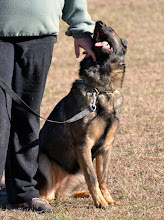When confined or "stuck" alone in an unfamiliar location, every puppy instinct says to cry out for help -- which is why puppies often get very upset when first crated.
Three primary factors that go into why a puppy cries in a crate when you first start crate training:
- Isolation
- Confinement
- Unfamiliar environment.
A basic rule of training is to only change one variable at a time (when possible). So, with puppies, I try to introduce them to a crate first with their littermates (and/or mom), this removes all 3 factors from play so that the crate environment becomes familiar in a likewise familiar location.
4. FOMO (fear of missing out)
Later, I will crate them side by side or 2-3 puppies together for meals. This isolates the confinement factor for them to learn about -- without also being isolated or in an unfamiliar environment. Gradually, the isolation factor will be increased -- from puppies in sight or even touching distance of others to just having littermates in proximity (can hear/smell but not see easily).
First meal in a closed crate for both of these boys. The yelling lasted 30 minutes and was followed by a 30 minute nap before they went outside for a potty break.
I don't believe most puppies are mature enough to handle isolation without stressing about it until after 7 weeks of age. (Of course, puppies worldwide have had to learn about isolation far earlier than 7 weeks -- whether because they were singleton puppies or because they were separated from mom and littermates at earlier ages. So often you hear of pups being sent home at 5 weeks -- just about the time they are eating and pooping and mom is no longer cleaning up -- that is, right when pups become work to keep clean and socialized to the world and people. And coinciding with this is a great number of pet dogs who end up with horrible separation anxiety.)
So I try to introduce the crate as a part of the environment in the whelping box and elsewhere at about 5 weeks -- puppies learn that they are shelter and napping places.
Around 6-7 weeks, I will start feeding pups in the crate(s) with the door open. And about 7 weeks, I shut them in the crate with a meal. Door closed. Locked in. And the crying is dramatic! But it will diminish and they generally fall asleep within 30 minutes. Because they are only facing 1 major stressor -- confinement -- without the elements of isolation and unfamiliarity/feeling unsafe.
Hopefully, by the time they go home at 8 weeks, they will be that much more prepared to face the new (necessary) and inescapable stressors of a new environment and the abrupt absence of their littermates and mom. I encourage new puppy owners to use the crate but not be super strict about it in the first 3 days. It's OK to be relaxed and let the puppies gain familiarity with their environment (outside of the crate and the new crate) and with the feeling of not having a sibling always right next to them. There's plenty of time to tighten the rules later - after the pup has adapted to the new family and new home.
So, when your 8 week old pup cries in her crate (or shut in the kitchen/laundry room/basement)-- it's not separation anxiety, it's *normal*. It's a rough part of learning about life with humans. It's instinct saying you're stuck and you're alone and you need to be rescued, so you better holler for help.


